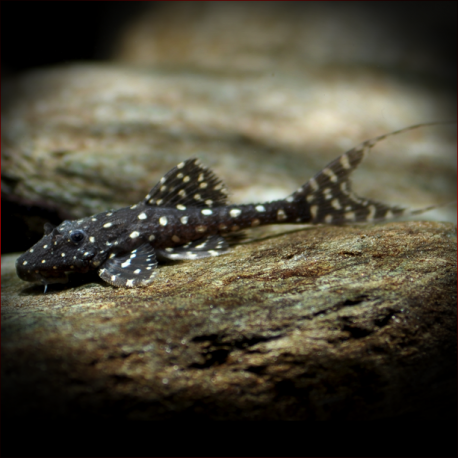More info
Datasheet
| Minimum Tank Size | 12000 litres / 3170.06 US gallons |
| Maximum Size | 100.0cm / 39.37inches |
| Temperature | 23°C / 73.40°F - 30°C / 86.00°F |
| Hardness | 2.02dgH / 36ppm - 12.05dgH / 215ppm |
| pH | 6.0-7.5 |
General Description
The Polka Dot Lyre Tail Pleco, scientifically known as Acanthicus Adonis, belongs to the Loricariidae family under the Siluriformes classification order. Reaching sizes of up to 100.0cm, this species is a generalised detrivore that thrives on a varied diet comprising dried, frozen, and live foods. They are recognizable by their striking spotted patterning as juveniles, which fades as they mature. Notably, adult specimens exhibit increasingly belligerent behavior as they age.
Aquarium Setup
To house the Polka Dot Lyre Tail Pleco successfully, a tank of at least 12000 litres is necessary, with dim lighting and refuges such as driftwood, large rocks, or lengths of plastic piping for hiding. While juveniles can be kept in planted tanks, adults tend to consume or uproot vegetation. A robust filtration system, regular water changes, and high dissolved oxygen levels are crucial due to the species' natural habitat preferences.
Behaviour
Juvenile Polka Dot Lyre Tail Plecos are typically peaceful but can become territorial and aggressive as they mature. Therefore, it is recommended to keep mature adults singularly, especially if the tank does not reach the magnitude of public aquaria. Suitable tankmates include large pelagic fishes from genera like Cichla, Osteoglossum, Brycon, and Acestrorhynchus.
Feeding and Diet
Being detrivores, Polka Dot Lyre Tail Plecos require a diverse diet that includes sinking tablets, wafers, fruits, vegetables, bloodworms, earthworms, prawns, cockles, and lancefish. To prevent malnourishment and stunted growth, adequate meal sizes and feeding frequencies are vital. When acquiring these catfish, visually check for signs of malnourishment such as sunken bellies or eyes.
Reproduction & Dimorphism
Reproduction information on the Polka Dot Lyre Tail Pleco is limited, but it is known to be a cave spawner, with males guarding and tending to the eggs. Sexual dimorphism is observable in males developing more extensive odontal growth on the pectoral rays, cheeks, and body. Additionally, males exhibit territorial behavior and possess a blunter-shaped genital papilla compared to females.
Habitat and Distribution
The Polka Dot Lyre Tail Pleco is found in slower-moving sections of rivers and tributaries, often in association with human settlements. Described from the lower Rio Tocantins in Brazil, this species is believed to inhabit various parts of the Amazon basin, with similar-looking specimens exported from regions like Peru.

